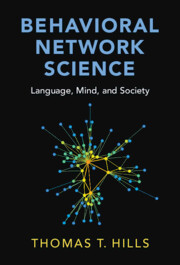Book contents
- Frontmatter
- Contents
- Additional Resources
- Introduction: Structure Matters
- Part I A Brief Guide to Network Science
- Part II Language
- 4 Zipf’s Law of Meaning: The Degree Distribution of the Mind
- 5 Network Learning: Growing a Lexicon by Degrees
- 6 What Is Distinctive: Exploring Edge Types in Multilayer Networks
- 7 The Small-World Spectrum: Using Small Worlds to Compare Networks
- 8 The Birthplace of New Words: Identifying Node Origins
- 9 Agent-Based Models of Language Emergence: Structure Favors the Orangutan
- Part III Mind
- Part IV Society
- References
- Index
5 - Network Learning: Growing a Lexicon by Degrees
from Part II - Language
Published online by Cambridge University Press: 08 November 2024
- Frontmatter
- Contents
- Additional Resources
- Introduction: Structure Matters
- Part I A Brief Guide to Network Science
- Part II Language
- 4 Zipf’s Law of Meaning: The Degree Distribution of the Mind
- 5 Network Learning: Growing a Lexicon by Degrees
- 6 What Is Distinctive: Exploring Edge Types in Multilayer Networks
- 7 The Small-World Spectrum: Using Small Worlds to Compare Networks
- 8 The Birthplace of New Words: Identifying Node Origins
- 9 Agent-Based Models of Language Emergence: Structure Favors the Orangutan
- Part III Mind
- Part IV Society
- References
- Index
Summary
The way networks grow and change over time is called network evolution. Numerous off-the-shelf algorithms have been developed to study network evolution. These can give us insight into the way systems grow and change over time. However, what off-the-shelf algorithms often lack are knowledge of the behavioral details surrounding a specific problem. Here we will develop a simple case that we will revisit over the next few chapters: How do children learn words from exposure to a sea of language? One possibility is that the words children learn first influence the words they learn next. Another possibility is that the structure of language itself facilitates the learning of some words over others. Indeed, we know that adults speak differently to children in ways that facilitate language learning, with semantically informative words tending to appear more often around words that children learn earliest. This invites the question: To what extent does the semantic structure of language predict word learning? This chapter will provide a general framework for building and competing models against one another with a specific application to the network evolution of child vocabularies.
Keywords
Information
- Type
- Chapter
- Information
- Behavioral Network ScienceLanguage, Mind, and Society, pp. 75 - 86Publisher: Cambridge University PressPrint publication year: 2024
